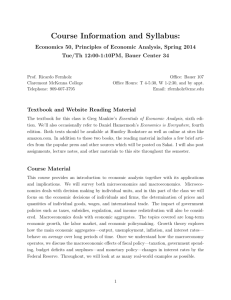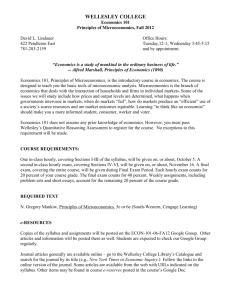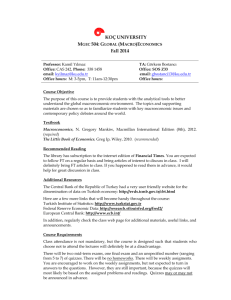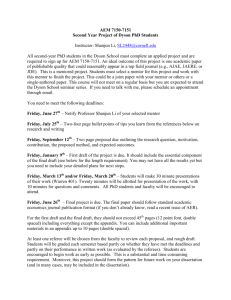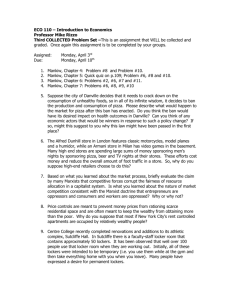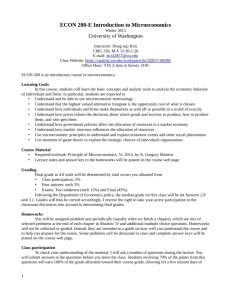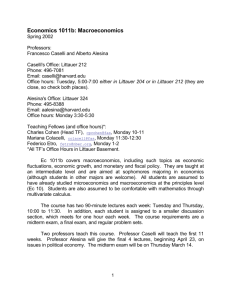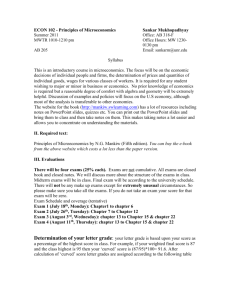Spring 2013 - Ricardo Fernholz
advertisement
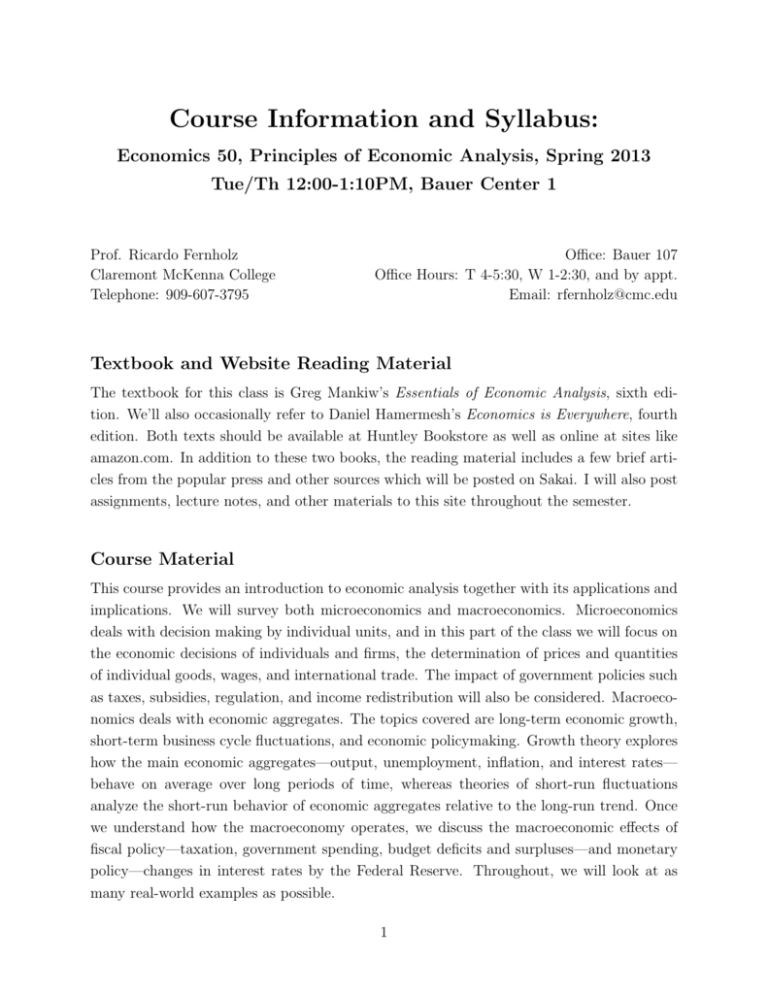
Course Information and Syllabus: Economics 50, Principles of Economic Analysis, Spring 2013 Tue/Th 12:00-1:10PM, Bauer Center 1 Prof. Ricardo Fernholz Claremont McKenna College Telephone: 909-607-3795 Office: Bauer 107 Office Hours: T 4-5:30, W 1-2:30, and by appt. Email: rfernholz@cmc.edu Textbook and Website Reading Material The textbook for this class is Greg Mankiw’s Essentials of Economic Analysis, sixth edition. We’ll also occasionally refer to Daniel Hamermesh’s Economics is Everywhere, fourth edition. Both texts should be available at Huntley Bookstore as well as online at sites like amazon.com. In addition to these two books, the reading material includes a few brief articles from the popular press and other sources which will be posted on Sakai. I will also post assignments, lecture notes, and other materials to this site throughout the semester. Course Material This course provides an introduction to economic analysis together with its applications and implications. We will survey both microeconomics and macroeconomics. Microeconomics deals with decision making by individual units, and in this part of the class we will focus on the economic decisions of individuals and firms, the determination of prices and quantities of individual goods, wages, and international trade. The impact of government policies such as taxes, subsidies, regulation, and income redistribution will also be considered. Macroeconomics deals with economic aggregates. The topics covered are long-term economic growth, short-term business cycle fluctuations, and economic policymaking. Growth theory explores how the main economic aggregates—output, unemployment, inflation, and interest rates— behave on average over long periods of time, whereas theories of short-run fluctuations analyze the short-run behavior of economic aggregates relative to the long-run trend. Once we understand how the macroeconomy operates, we discuss the macroeconomic effects of fiscal policy—taxation, government spending, budget deficits and surpluses—and monetary policy—changes in interest rates by the Federal Reserve. Throughout, we will look at as many real-world examples as possible. 1 Assignments, Exams, and Grading There will be three assignments in this class and the due dates for these assignments are noted on the course schedule below. I’ll post the assignments to Sakai at least two weeks before they are due. It is okay to discuss and collaborate on these, but each person must hand in his or her own copy of the completed assignments. No late assignments will be accepted. There will be two midterm exams and one comprehensive final exam in this class. All exams will be closed-book and closed-notes. There are no make-up exams. There will also be four in-class quizzes, each lasting roughly 20-25 minutes. Finally, there will be a series of brief reading assignments whose completion will count as the bulk of the class participation grade. The final grade for this class will be based on the assignments and exams using the following weighting scheme: 5% Participation 10% Assignments 10% Quizzes 20% Midterm 1 20% Midterm 2 35% Final exam Disability If you have any problems with the terms of this syllabus due to a disability you must notify me within the first two weeks of the semester. Note that if you require alternative arrangements for the exams I must be contacted by the Dean of Students, but it is also your responsibility to coordinate with me about the time and place of your exam at least two weeks before that exam. Preliminary Course Schedule January 22: Introduction January 24: Economics, Scarcity, and Choice (Mankiw Ch. 1, Hamermesh Ch. 1) January 29: Comparative Advantage and Trade (Mankiw Ch. 3, Hamermesh Ch. 20) 2 January 31: Supply and Demand (Mankiw Ch. 4, Hamermesh Ch. 2) February 5: More Supply and Demand (Mankiw Ch. 4, Hamermesh Ch. 3) February 7: Elasticity, Quiz 1 (Mankiw Ch. 5, Hamermesh Ch. 5) February 12: More Elasticity (Mankiw Ch. 5) February 14: Supply, Demand, and the Government (Mankiw Ch. 6, Hamermesh Ch. 4) February 19: Efficient Markets, Assignment 1 due in class (Mankiw Ch. 7) February 21: Market Efficiency and the Effect of Taxes (Mankiw Ch. 8) February 26: Externalities, Quiz 2 (Mankiw Ch. 10, Hamermesh Ch. 18—only the part on externalities) February 28: Review March 5: Midterm 1 March 7: Firms and the Cost of Production (Mankiw Ch. 12, Hamermesh Ch. 7) March 12: Firms, Production Costs, and Competitive Markets (Mankiw Ch. 12, Hamermesh Ch. 8-9) March 14: The Behavior of Firms in Competitive Markets (Mankiw Ch. 13, Hamermesh Ch. 10) March 19: No Class, Spring Break March 21: No Class, Spring Break March 26: Monopoly and Firm Behavior (Mankiw Ch. 14, Hamermesh Ch. 12) March 28: More Monopoly, Quiz 3 (Mankiw Ch. 14, Hamermesh Ch. 13) 3 April 2: Introduction to Macro: Measuring the Economy (Mankiw Ch. 15, An Aberrant Abacus) April 4: Measuring the Cost of Living, Assignment 2 due in class (Mankiw Ch. 16) April 9: Review April 11: Midterm 2 April 16: Economic Growth and Productivity (Mankiw Ch. 17) April 18: Long-Run Economic Growth (Mankiw Ch. 17, Hong Kong in Honduras) April 23: Saving and Investment (Mankiw Ch. 18) April 25: Unemployment and Wages, Quiz 4 (Mankiw Ch. 20, Decline of the Working Man) April 30: Money and the Monetary System (Mankiw Ch. 21) May 2: Short-run Economic Fluctuations, Assignment 3 due in class (Mankiw Ch. 22) May 7: Review Common Final Exam: Friday, May 17 from 2-5pm, Location TBA This schedule is preliminary and is subject to change during the semester as needed. 4
